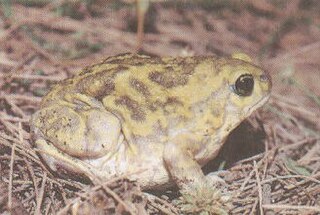
The Microhylidae, commonly known as narrow-mouthed frogs, are a geographically widespread family of frogs. The 683 species are in 57 genera and 11 subfamilies.

Plethodontohyla is a genus of microhylid frogs endemic to Madagascar.

The Microhylinae are a subfamily of microhylid frogs. It contains 9 genera. Phylogenetic studies have estimated the family Microhylidae to be about 52 million years old.

Chiromantis is a genus of frogs in the family Rhacophoridae, commonly known as foam-nest frogs or foam-nest tree frogs. It contains species from the Sub-Saharan African tropics. Following the molecular genetic study by Chen and colleagues (2020), the Asian species formerly assigned to Chiromantis have now been reclassified to the resurrected genus Chirixalus.

Austrochaperina is a genus of microhylid frogs found on New Guinea, New Britain and Australia.
Copiula is a genus of microhylid frogs endemic to New Guinea. The common name Mehely frogs has been coined for them. They are leaf-litter inhabitants.

Kalophrynus is a genus of microhylid frogs. It is the only genus in the subfamily Kalophryninae. The species in this genus are found in southern China, in Southeast Asia to Java and Philippines, and in Assam, India.

Uperodon is a genus of microhylid frogs. They occur in South Asia and Myanmar. Uperodon reached its current composition in 2016 when the genus Ramanella was brought into its synonymy. The common names of these frogs are globular frogs and balloon frogs in reference to their stout appearance, or dot frogs, the last specifically referring to the former Ramanella.

Glyphoglossus brooksii is a species of frog in the family Microhylidae. It is endemic to Borneo and found in Kalimantan (Indonesia) and Sarawak (Malaysia). Its common names are Brooks' squat frog and Brooks' burrowing frog. It is named after Mr. Cecil J. Brooks who collected the holotype "in a hole whilst prospecting" in Bidi, Sarawak.
Glyphoglossus flavus is a species of frog in the family Microhylidae. It is endemic to Borneo and is known from the Gunung Mulu National Park in Sarawak (Malaysia), Danum Valley Conservation Area in Sabah (Malaysia), and Ulu Temburong National Park in Brunei. Common names Borneo squat frog and yellow burrowing frog have been coined for it.
Glyphoglossus minutus, also known as the minute narrow-mouthed frog, is a species of frog in the family Microhylidae. The specific name minutus alludes to the small size of this species. It is endemic to Peninsular Malaysia and only known from four localities in the state of Pahang: two inside the Taman Negara National Park, one in the Krau Wildlife Reserve, and Gunung Senyum. It probably occurs more widely in central Peninsular Malaysia.
Glyphoglossus smithi, also known as Smith's squat frog or Smith's burrowing frog, is a species of frog in the family Microhylidae. It is endemic to Sabah and Sarawak in Malaysian Borneo. However, it is likely to occur more widely than currently known and be present in Brunei and Indonesia. The specific name smithi honours Dr Harrison Willard Smith, an American scientist who collected the holotype from the Limbang River district.

Glyphoglossus molossus is a species of frog in the family Microhylidae. Its common names include blunt-headed burrowing frog and balloon frog.
Kalophrynus eok is a species of frog in the family Microhylidae. It is endemic to Borneo and currently only known from its type locality in the Kelabit Highlands of Sarawak, Malaysia, but presumably, it also occurs in the adjacent Kalimantan, Indonesia. The specific name eok is Kelabit for "tiny" and refers to the small size of this species. Common names eok sticky frog and small Bario sticky frog have been coined for it.
Ansonia echinata is a species of toads in the family Bufonidae. It is endemic to Sarawak, Borneo. Common name spiny slender toad has been coined for this little known species.
Ansonia vidua is a species of toads in the family Bufonidae. It is endemic to Sarawak, Borneo. Common names Murud black slender toad and widow slender toad have been coined for this little known species. The latter name refers to the black colouration of this species and the fact that no male individuals are known.
Ansonia teneritas, the gracile slender toad, is a species of toad in the family Bufonidae, described in 2016. It is endemic to central Sarawak in Malaysian Borneo and is only known from two isolated mountain ridges. Its name is derived from its slender body.
Philautus macroscelis, the mossy bush frog, is a species of frog in the family Rhacophoridae. It is endemic to Brunei, Malaysia, and Borneo. It is suspected in Indonesia. It has been observed between 750 and 1800 meters above sea level.









